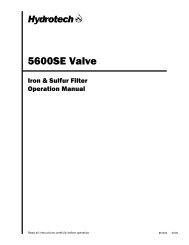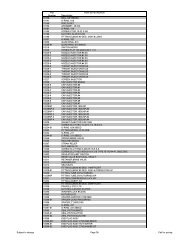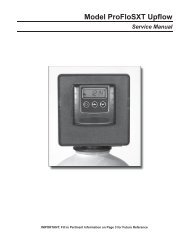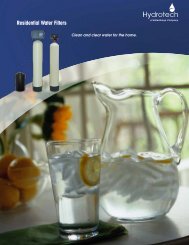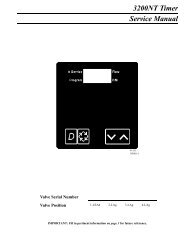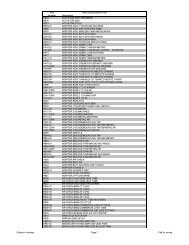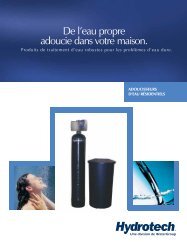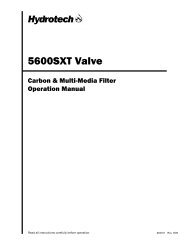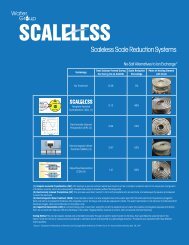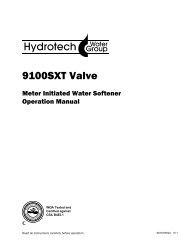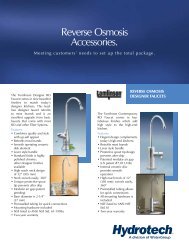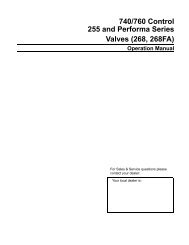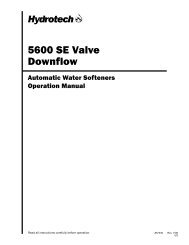5600 Calendar Clock Valve - Hydrotech
5600 Calendar Clock Valve - Hydrotech
5600 Calendar Clock Valve - Hydrotech
You also want an ePaper? Increase the reach of your titles
YUMPU automatically turns print PDFs into web optimized ePapers that Google loves.
Maintenance<br />
Checking the Salt Level<br />
Check the salt level monthly. Remove the lid from the cabinet or brine tank, make sure salt level is always above the<br />
brine level (you should not be able to see water).<br />
Adding Salt<br />
Use only clean salt labeled for water conditioner use, such as crystal, pellet, nugget, button or solar.<br />
The use of rock salt is discouraged because it contains insoluble silt and sand which build up in the brine tank and can<br />
cause problems with the system’s operation. Add the salt directly to the tank, filling no higher than the top of the brine<br />
well.<br />
Caution<br />
Liquid brine will irritate eyes, skin and open wounds - gently wash exposed area with fresh water. Keep children away<br />
from your water conditioner.<br />
Bridging (Figure 7)<br />
Humidity or wrong type of salt may create a cavity between the water and the salt. This<br />
action, known as “bridging”, prevents the brine solution from being made, leading to your<br />
water supply being hard.<br />
If you suspect salt bridging, carefully pound on the outside of the brine tank or pour some<br />
warm water over the salt to break up the bridge. This should always be followed up by<br />
allowing the unit to use up any remaining salt and then thoroughly cleaning out the brine<br />
tank.<br />
Allow four hours to produce a brine solution, then manually regenerate the softener.<br />
Care of Your Softener<br />
To retain the attractive appearance of your new water softener, clean occasionally with mild soap solution. Do not use<br />
abrasive cleaners, ammonia or solvents. Never subject your softener to freezing or to temperatures above 110°F (43°C).<br />
Cleaning the Injector Assembly (Figure 8)<br />
Sediment, salt and silt will restrict or clog the injector. A clean water<br />
supply and pure salt will prevent this from happening.<br />
The injector assembly is located on the right side of the control valve.<br />
This assembly is easy to clean.<br />
Shut off the water supply to your softener and reduce the pressure by<br />
opening a cold soft water faucet. Using a screwdriver, remove the two<br />
screws holding the injector cover to the control valve body. Carefully<br />
remove the assembly and disassemble as shown in Figure 8. The<br />
injector orifice is removed from the valve body by carefully turning it<br />
out with a large screwdriver. Remove the injector throat the same way.<br />
Carefully flush all parts including the screen. Use a mild acid such as<br />
vinegar or Pro-Rust Out to clean the small holes in the orifice and<br />
throat.<br />
Reassemble using the reverse procedure.<br />
Resin Cleaner<br />
An approved resin cleaner must be used on a regular basis if your water supply contains iron. The amount of resin cleaner<br />
and frequency of use is determined by the quantity of iron in your water (consult your local representative or follow the<br />
directions on the resin package).<br />
6<br />
Figure 8<br />
Figure 7<br />
INJECTOR BODY<br />
INJECTOR THROAT<br />
INJECTOR NOZZLE<br />
“O” RING<br />
INJECTOR COVER<br />
SCREW<br />
INJECTOR SCREEN



